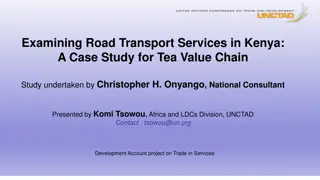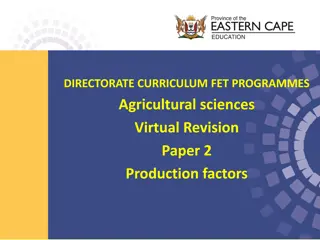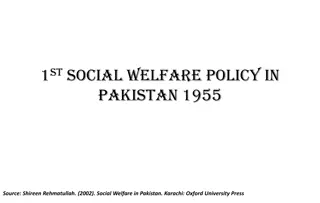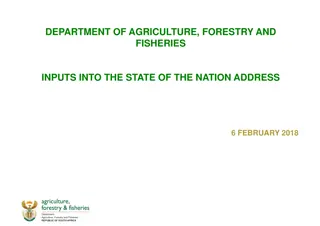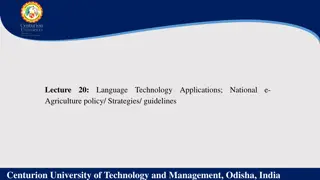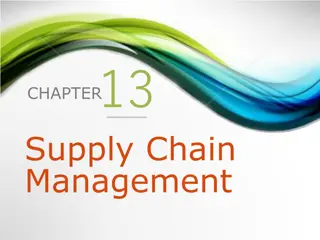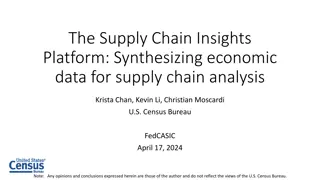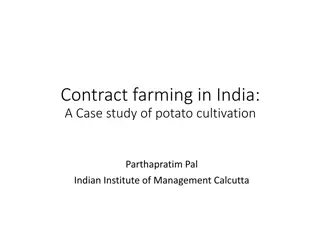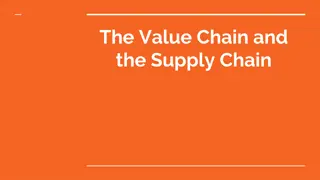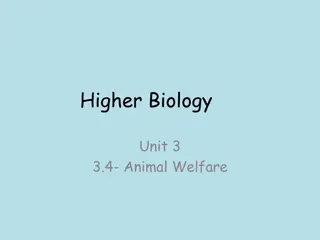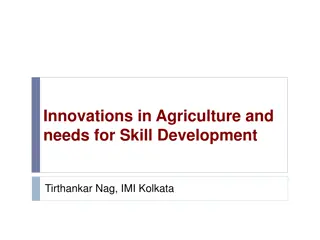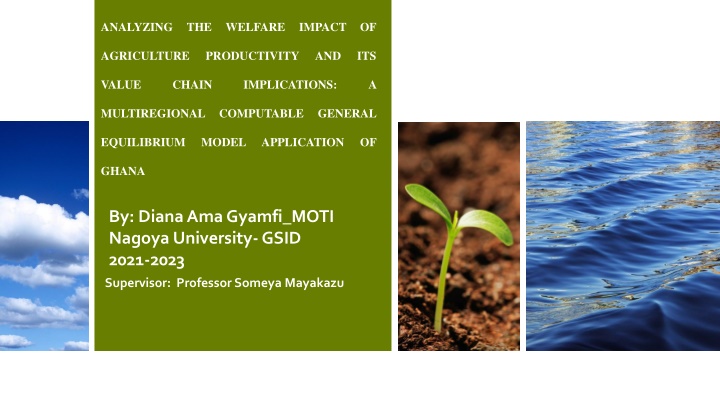
Welfare Impact of Agriculture Productivity in Ghana: A Multiregional Study
This research focuses on examining the welfare impact of agriculture productivity in Ghana, particularly in regions heavily reliant on agriculture. The study highlights the role of Total Factor Productivity (TFP) in poverty reduction and evaluates the value chain implications. Recommendations are made to improve public resources allocation to agriculture for enhanced economic development.
Download Presentation

Please find below an Image/Link to download the presentation.
The content on the website is provided AS IS for your information and personal use only. It may not be sold, licensed, or shared on other websites without obtaining consent from the author. If you encounter any issues during the download, it is possible that the publisher has removed the file from their server.
You are allowed to download the files provided on this website for personal or commercial use, subject to the condition that they are used lawfully. All files are the property of their respective owners.
The content on the website is provided AS IS for your information and personal use only. It may not be sold, licensed, or shared on other websites without obtaining consent from the author.
E N D
Presentation Transcript
ANALYZING THE WELFARE IMPACT OF AGRICULTURE PRODUCTIVITY AND ITS VALUE CHAIN IMPLICATIONS: A MULTIREGIONAL COMPUTABLE GENERAL EQUILIBRIUM MODEL APPLICATION OF GHANA By: Diana Ama Gyamfi_MOTI Nagoya University- GSID 2021-2023 Supervisor: Professor Someya Mayakazu
OUTLINE OF PRESETATION INTRODUCTION RESEARCH OBJECTIVE PROBLEM STATEMENT METHODOLOGY AND DATA RESULTS AND DISCUSSIONS RECOMMENDATION CONCLUSION 2 3/20/2025 Add a footer
INTRODUCTION Ghana s plight in poverty reduction is worsening especially in regions where most households are engaged in agriculture though improved public resources allocation to agriculture has improved making agriculture expenditure increase consistently (NDPC, 2020). Agriculture accounts for over 80% of the livelihood of the rural population and yet GDP contribution is currently at 4.2 percent despite the central role the sector plays in economic development (GSS, 2023). 3 3/20/2025 Diana Ama Gyamfi, Nagoya University (GSID)
Agriculture productivity and Poverty reduction Agriculture s role in poverty reduction has been linked to productivity and hence the participation of agriculture in poverty reduction is productivity-dependent (Ivanic & Martin, 2017). Total Factor Productivity (TFP) is the efficient combination of inputs such as fertilizer intermediate inputs like equipment and machinery, use of energy and road infrastructure to produce output, and agriculture is more dependent on TFP for the eradication of poverty (Fuglie, Gautam, Goyal, & Maloney, 2019). The authors argue that, TFP embodies a more thorough way to measure technology employment and the subsequent change in efficiency in an economy and very useful in agriculture development since productivity growth by land expansion gets limited as the economy advances due to other competitive use for the land and leading labor and capital to face diminishing returns (Fuglie, Gautam, Goyal, & Maloney, 2019). The impact of agriculture productivity is twice more impactful on poverty reduction than any other sector s poductivity increase (Ivanic and Martin, 2017) 4 3/20/2025 Diana Ama Gyamfi: Graduate School of International Development_ Nagoya University
Evolution of agriculture productivity enhancing policies- Global(SDGs), Regional(AU (NEPAD)) AGENDA 2063 + MALABO DECLARATION (2014 - 2015) CAADP (2003) MAPUTO DECLARATION (2003) Comprehensive African Agriculture Development Policy (for Africa s agriculture transformation) Goals 1. end extreme poverty 2. end hunger and malnutrition by 2025, 3. Africa to become a net food exporter 3. Where there is comparative advantage, make Africa a top value exporter in the GVC All government s commitment of 10% of public resources to Agriculture expenditure AU 1stdeclaration on CAADP 2014: Reduce all poverty incidences occurring in 2013 by 30% in 2017. Stresses on Maputo declaration to reconfirm agriculture as key on the economic development agenda of Africa with concerns on limited agro-industry and agribusiness development recognizing intersectoral collaboration for sound agriculture sector productivity development. Reduce poverty by 50% 5 3/20/2025 Diana Ama Gyamfi, Nagoya University (GSID)
Overview of Ghanas Recent Agriculture productivity Policies 1st Long Term Agriculture policy Implemented in 2002 Main objective: Agriculture modernization FASDEP I (Food and Agriculture Sector Development Policy I) 2nd Long Term Agriculture Policy FASDEP II, the revised initial FASDEP I (MoFA. 2007) Developed 2007 Under the Framework of CAADP with 10% pledge of budget allocation to agriculture Targets 6 8 % annual growth rate in agriculture Mode of Implementation of (MoFA. 2023) METASIP (medium term Agriculture Sector Investment Plan) FASDEP II Implemented 2011 Sub-Policies initiated - 1. Planting for Food and Jobs: In line with CAADP Agenda 2063: Input subsidy programe- 50% on seeds and fertilizer Target : 50,000 direct beneficiaries; 250,000 farmers, 50% being women and youth with 5 pillar auxiliary programs including extension, marketing, and e-agriculture. Roping in 1D1F Savanna Zone Agriculture Productivity Improvement Policy (SZAPIP)- Deseigned 2018 towards poverty alleviation working hand in hand with PFJ 2.Investing for Food and Jobs 3/20/2025 Add a footer 6
Status of poverty situation in Ghana According to NDPC, 2020, in their SDG 2020 report, overall poverty rates increased in 3 regions; Upper East Region increased from 31% - 40%; Brong-Ahafo increased from 13.3% - 13.8%; Northern Region increased from 36.0% - 39.3%; Savanah Region (3 northern region clusters)- the most impoverished region in Ghana also increased in poverty from 55.0% to 64.0%; About 4 regions were found below the national poverty lines after 2017. The rural poverty- rose from 64.6% to 66.2 % twice that of urban households and worse among households headed by agriculture sector workers. Even through the government has met the goal of spending 10% public resources in agriculture development according to the report. 8 3/20/2025 Diana Ama Gyamfi, Nagoya University (GSID)
Spatial distribution of households in agriculture 9 3/20/2025 Diana Ama Gyamfi
Ghana Regional Distribution of Households in Agriculture Versus Their Per Capita Income 90.00% 60000 80.00% 50000 70.00% 60.00% 40000 income in GHC 50.00% 30000 40.00% 30.00% 20000 20.00% 10000 10.00% 0.00% 0 Percentage of Households owning/operating a farm Mean Percapita Income Source:Author s estimation with data from GLSS7 10 3/20/2025 Diana Ama Gyamfi, Nagoya University (GSID)
Share of value-added agriculture to GDP versus government expenditure in agriculture 70.00 18000 16000 60.00 14000 50.00 million US$ (2015 prices) 12000 40.00 percent 10000 8000 30.00 6000 20.00 4000 10.00 2000 0.00 0 1984 1988 1981 1982 1983 1987 2020 1980 1985 1986 1989 2021 2008 2001 2002 2003 2006 2007 2009 2000 2004 2005 2010 2014 2015 2011 2012 2013 2017 1994 2016 2018 2019 1991 1992 1997 1990 1993 1998 1999 1995 1996 value Added agriculture share of GDP Government expecditure in Agriculture, forestry, fishing (Central Government) millions US$, 2015 prices Source:Author s estimates: data from (World Bank, 2023) & (FAOSTAT, 2023) 11 3/20/2025 Diana Ama Gyamfi, Nagoya University (GSID)
PROBLEM STATEMENT According to Ghana s 2020 SGDs report, an estimated 77% of Ghanaian households (22 million people) had a reduction in income due to COVID-19 impacts on the economy including Factors from external war potentially producing about 4 million new poor people across the country. Taking Ghana s level where it was over 15 years ago in 2005/2006 (NDPC, 2020). There are three main points stated in the SDG 2020 report on Ghana as challenges; Rising prevalence of poverty within the country; low resilience of the nation to global external shocks; increasing spatial and income inequality. These make it difficult against the Government's effort to reduce poverty. According to the Ghana SDG report 2020, the agriculture investment share of Total Government Expenditure increased from 6.4% to 10.1% within 3 years, 2015-2018 in line with the Agriculture Index target of (10%) yet Value Added Agriculture has not seen much improvement. Challenges of The National Agriculture Investment Plan (NAIP) Low public sector investment as one of the key issues facing agriculture development, low levels of employment in science and technology Inadequate access to mechanization. of Ghana (MOFA, 2023). 12 3/20/2025 Diana Ama Gyamfi, Nagoya University (GSID)
RESEARCH OBJECTIVE Expand a CGE model to Agriculture productivity simulations in a multiregional fashion to estimate the impacts of productivity enhancement policies in agriculture on sub-national and national welfare for regional development. RESEARCH QUESTIONS I. Which agriculture productivity policies will improve welfare gain with emphasis on the poorest regions to bring about the greatest welfare impact? II. What are the important subnational industrial/ economic linkages between regions as a result of the productivity increase of each region? 13 3/20/2025 Diana Ama Gyamfi, Nagoya University (GSID)
METHODOLOGY AND DATA Multiregional CGE model with 2015 SAM data sourced from Ghana statistical Service and the European Union. CGE APPLICATION Computable General Equilibrium. DATA Social Accounting Matrix 2015 of Ghana, by Ghana Statistical Service and the European Union 14 3/20/2025 Add a footer
Some Features of the SAM 2015 Data in Million Gh Cedis FEATURES CATEGORIES Agriculture Commodities (Home grown Home use) 14 Marketed Agriculture commodities 41 Factors of Production (land , labor, capital) 60 Factor land (by regions) 10 Factor labor (by educational attainment, rural or urban and by region) 60 Factor capital (crops, livestock, mining, others) 4 Activities ; Agriculture (segregated by 10 regions) 10 Activities ; Others (across sectors of manufacturing, industry and service) 45 Institutional Accounts (segregated by regions and 5 income quintiles each = 100 institutions, then Enterprises, Government and ROW 103 Tax account (Direct, Sales, Import and Export) 4 15 3/20/2025 Add a footer
Adiagrammatic presentation of the production technology and marketed commodities structure of the CGE model Source: Authors modification based on (Otchia C. S., 2014) 16 3/20/2025 Add a footer
Spatial distribution of subsistence and commercial Agriculture valued in million GH versus regional income distribution. Home produced for consumption Add a footer
Scatter plot of sectorial value-added share versus employment share 40.00 Private Services 35.00 30.00 Public Services 25.00 % semployment share 20.00 15.00 Agric crops (marketed) 10.00 Construction Other services 5.00 Oil & mining subsistence Manufacturing Livestock Forestry Food processing Fishing Utilities 0.00 -2.00 3.00 8.00 13.00 18.00 23.00 28.00 33.00 38.00 -5.00 % value added share in GDP Source: Author's estimates based on SAM 2015 data on Ghana 18 3/20/2025 Add a footer
Simulation Design Scenario Simulation Description 1 10% TFP National 2 10% TFP Per region while holding other regions constant. 3 10% Land productivity Northern, Upper East, and Upper West regions 4 10% Increase in capital Northern, Upper East, and Upper West regions stock 7% TFP 5 Northern region 19 3/20/2025 Diana Ama Gyamfi, Nagoya University (GSID)
RESULTS AND DISCUSSION 20 3/20/2025 Add a footer
Macro Economic impact of 10% TFP by regions (% change from base) Base (million GHC) Nationa l Wester n Greater Accra Ash- anti Brong Ahafo Norther n Upper East Upper West MACRO Central Volta Eastern REAL CHANGES Absorption Private Consumptio n 149.49 8.99 0.14 0.15 0.06 0.14 0.31 0.16 0.25 0.21 0.10 0.02 88.65 15.16 0.24 0.26 0.10 0.24 0.52 0.26 0.43 0.36 0.17 0.03 Exports 52.26 11.97 0.03 0.07 0.03 0.03 0.14 0.04 0.10 0.07 0.00 0.01 Imports -64.84 9.65 0.02 0.06 0.02 0.03 0.11 0.03 0.08 0.05 0.00 0.01 GDP Net income tax 136.90 9.81 0.15 0.17 0.06 0.16 0.34 0.17 0.28 0.23 0.11 0.02 15.06 11.60 0.13 0.12 0.02 0.05 0.22 0.09 0.24 0.12 0.05 0.02 21 3/20/2025 Diana Ama Gyamfi, Nagoya University (GSID)
Regional production expansion and externalities due to 10% TFP simulation While holding other regions constant, some regions responded positively with a boost in their production base due to TFP simulation in other regions. These signify some economic forward linkages. 22 3/20/2025 Diana Ama Gyamfi, Nagoya University (GSID)
The Northern region and Upper east show the highest number of interlinkages with other regions due to the TFP boost upper West region s production expansion due to the TFP simulation is 11.81 percent, the highest response among the ten regions and the only region which did not exhibit any positive externality to any other region. The region s productivity boost resulted in an expansion in the production of other agro-processing sectors by 0.59 percent of which textiles and clothing account for 0.53 percent. 23 3/20/2025 Diana Ama Gyamfi, Nagoya University (GSID)
Food and Agro- processing and Forestry sectorial impacts due to 10 percent TFP The Volta region is well endowed in Sugar refining activity. the specific sectors can be focal points for government intervention policies for agriculture industrialization. 24 3/20/2025 Diana Ama Gyamfi, Nagoya University (GSID)
Beverages, Tobacco, and other agro-processing regional comparative advantage resulting from 10% TFP simulation. The beverages and tobacco processing sectors are expanded by only 3 regions; Northern, Upper East, and Upper West. Other agro processing activities such as textiles, clothing, leather and foot wear, 25 3/20/2025 Diana Ama Gyamfi, Nagoya University (GSID)
Change in consumption expenditure by household quintiles due to 10% TFP An increase in consumption expenditure is more among the rural quintiles than the urban quintiles (uq1-5) in a similar fashion except for the two regions; Northern and Upper East exhibited a similar pattern in the reverse while the Northern region exhibited a trend where all income quintiles experienced a similar level of reduction in consumption except income quintiles 4 and 5 of the urban households. Rural income quintiles (rq1-5) mostly reduced in consumption expenditure. This means the rich get to spend more which will eventually increase the income of the poor who are mostly engaged in agriculture. 26 3/20/2025 Diana Ama Gyamfi, Nagoya University (GSID)
Change in consumption expenditure due to land, labor and capital productivity (Northern, Upper East, Upper West) Upper west (Land) Upper East (Land) North(Land) 0.2 0.4 1 % change 0.15 % change 0.3 % change 0.1 0.2 0.5 0.05 0.1 0 0 0 rq1 rq2 rq3 rq4 rq5 uq1 uq2 uq3 uq4 uq5 rq1 rq2 rq3 rq4 rq5 uq1 uq2 uq3 uq4 uq5 rq1 rq2 rq3 rq4 rq5 uq1 uq2 uq3 uq4 uq5 Upper East (labor) Upper West (labor) North( Labor) 0.4 0.2 1 % change % change 0.3 0.15 % change 0.2 0.1 0.5 0.1 0.05 0 0 0 rq1 rq2 rq3 rq4 rq5 uq1 uq2 uq3 uq4 uq5 rq1 rq2 rq3 rq4 rq5 uq1 uq2 uq3 uq4 uq5 rq1 rq2 rq3 rq4 rq5 uq1 uq2 uq3 uq4 uq5 North (capital) Upper East (capital) Upper East (capital) 1 0.4 0.2 % change % change % change 0.3 0.15 0.5 0.2 0.1 0.1 0.05 0 0 0 rq1 rq2 rq3 rq4 rq5 uq1 uq2 uq3 uq4 uq5 rq1 rq2 rq3 rq4 rq5 uq1 uq2 uq3 uq4 uq5 rq1 rq2 rq3 rq4 rq5 uq1 uq2 uq3 uq4 uq5 27 3/20/2025 Diana Ama Gyamfi, Nagoya University (GSID)
Change in factor prices as a result of 10% TFP by region. Upper West Upper East Northern BrongAhafo Ashanti Eastern Volta Greater Accra Central Western -8 -6 -4 -2 0 2 4 6 8 % change in factor price land rent change urban skilled urban semi-skilled urban unskilled rural skilled rural semi-skilled rural unskilled 28 3/20/2025 Diana Ama Gyamfi, Nagoya University (GSID)
Change in factor price due to land, labor, and capital productivity (Northern, Upper East, Upper West) Upper West (labor) Upper East (labor) North( Labor) Upper west (Land) Upper East (Land) North(Land) 0 0.2 0.4 0.6 0.8 1 1.2 1.4 1.6 1.8 % change in factor price urban skilled urban semi-skilled urban unskilled rural skilled rural semi-skilled rural unskilled land rent change 29 3/20/2025 Diana Ama Gyamfi, Nagoya University (GSID)
Welfare Analysis Compensation variation is the amount by which a population is compensated in welfare as a result of policy implementation. The rural income quintiles were compensated more than the urban quintiles. Except for Greater Accra. Upper East and Upper West are lost welfare too. Except Upper East q1-3, and q4 of Upper West. 30 3/20/2025 Diana Ama Gyamfi, Nagoya University (GSID)
WELFARE IMPACT OF LAND AND LABOR, CAPITAL PRODUCTIVITY SIMULATIONS 31 3/20/2025 Diana Ama Gyamfi, Nagoya University (GSID)
RECOMMENDATION 1. Upper West region: Government can help create the enabling environment for value addition in their cotton which can feed into the textile manufacturing industries located in other regions. 2. Northern and upper East Region: the government should create the right enabling environment for private sector involvement with the right innovations and funding to set up a meat processing and dairy industry in the Northern region that can serve the whole nation. 32 3/20/2025 Add a footer
Recommendations cont. 1. Encouraging the setting up of a sugar refinery in the Volta region can help create jobs and reduce its imports to alleviate poverty as the region shows high levels of expansionary potential for this sector when its productivity level is boosted. 2. Government should incentivize the sectors responsible to produce intermediate goods like chemicals, equipment, and machinery that will boost domestic production to support agricultural industrialization. 33 3/20/2025 Add a footer
CONCLUSION As per the results and discussions above, the improvement in Productivity in agriculture is evident in poverty reduction but clearly reflects various heterogeneity across space sub-nationally in Ghana. Specific focus be given to the poorest regions endowment and their revealed production advantages for example, cotton production links to the textile industry for Upper West; Meat supply linkages for the Northern region and beverage and tobacco processing linkage industry for Upper East. These can be key focal points for policy in developing these regions towards poverty reduction. Exposure to different linkage industries accompanying each region s productivity informs the government on which industries to prioritize for each region s agriculture industrialization as well Poverty-targeting policies are an important way to reduce poverty and inequality in a sustainable way through agricultural productivity. This study has been worthwhile in specifying which policies will be best for specific regions, especially those regions that have been lagging in poverty reduction. 34 3/20/2025 Diana Ama Gyamfi, Nagoya University (GSID)
Some References Bautista, R. M. (1986). Effects of Increasing Agricultural Productivity in a Multisectoral Model for the Philippines. Agricultural Economics, 67 - 85. Boulanger, P., Dudu, H., Ferrari, E., & Mainar, A. (2018). Policy options to support the Agriculture Sector Growth and Transformation. Luxembourg: Joint Research Center, European Union. Retrieved from Policy options to support the Agriculture Sector Growth and Transformation Breisinger, C., Diao, X., Thurlow, J., & Al-Hassan, R. M. (2008). IFPRI Discussion Paper 00784 Agriculture for Development in Ghana New Opportunities and Challenges. Washinton DC: INTERNATIONAL FOOD POLICY RESEARCH INSTITUTE. Breisinger, C., Diao, X., Thurlow, J., & Hassan, R. M. (2011). Potential Impacts of a Green Revolution in Africa The Case of Ghana. Journal of International Development, 82 - 102. vanic, M., & Martin, W. (2017). Sectoral Productivity Growth and Poverty Reduction: National and Global Impacts. World Development, 109, 429 - 439. Retrieved 5 2, 2023, from www.elsevier.com/locate/worlddev Joachim Von Braun, R. E.-L. (2009). The Poorest and Hungry; Accessment, Analysis and Actions. Intl Food Policy Res Inst (IFPRI). NDPC. (2020). Ghana SDGs Report. Accra: National Development Planning Commission (NDPC). Otchia, C. S. (2014). Agricultural Modernization, Structural Change and Pro-poor Growth: Policy Options and Pro- poor Growth: Policy Options. Journal of Economic Structures. GSS. (2019). Ghana Living Standards Survey round 7. Accra: Ghana Statistical Service. 35 3/20/2025 Diana Ama Gyamfi, Nagoya University (GSID)
THANK YOU FOR YOUR ATTENTION 36 3/20/2025 Diana Ama Gyamfi, Nagoya University (GSID)



